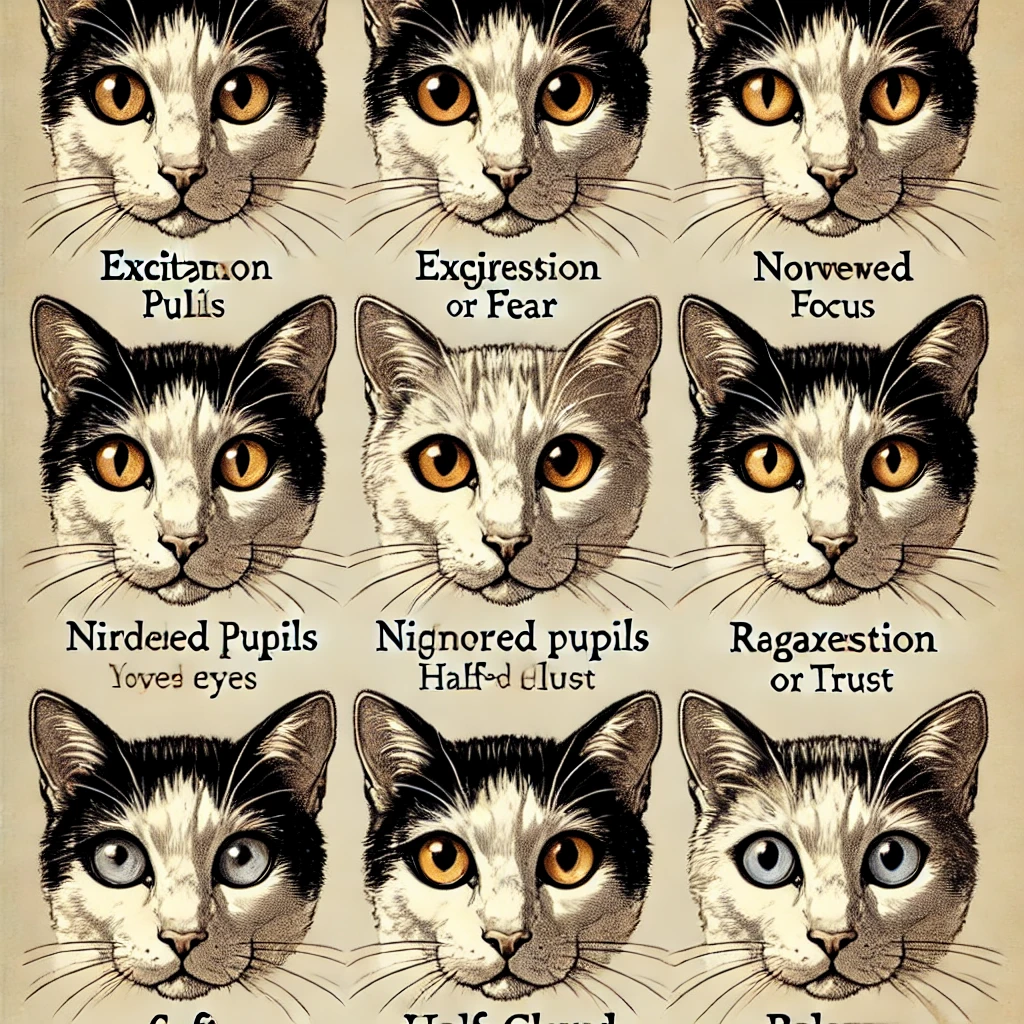Unlock the secrets of your cat’s emotions by understanding their cat eye language.
Introduction
Have you ever looked into your cat’s eyes and wondered what they’re thinking? Cat eye language is a fascinating aspect of feline communication that can reveal a lot about your cat’s mood and intentions. By learning to interpret your cat’s eye expressions—including pupil size, gaze direction, and eyelid position—you can deepen your bond and respond more effectively to their needs.
How Pupil Dilation Relates to Excitement, Fear, or Aggression
Understanding Cat Eye Language Through Pupil Size
A cat’s pupils can change size rapidly in response to light conditions, but they also reflect emotional states.
Dilated Pupils
- Excitement or Playfulness: When your cat is ready to pounce on a toy, you might notice their pupils become large and round. This indicates heightened excitement and readiness for action.
- Fear or Anxiety: Wide, dilated pupils can also signify fear. If your cat encounters a stressful situation—like a loud noise or unfamiliar environment—their pupils may dilate as a physiological response to help them see better and react quickly.
- Aggression: In some cases, dilated pupils may be a warning sign of aggression, especially if accompanied by hissing or growling.
Constricted Pupils
- Aggression or Anger: Narrowed pupils can indicate that a cat is feeling aggressive or irritated. If your cat’s eyes become slits and they are displaying other signs of aggression, it’s best to give them space.
- Focused Attention: When stalking prey (or a toy), a cat’s pupils may constrict to sharpen their focus.
Context Matters in Cat Eye Language
Always consider the situation and other body language cues when interpreting pupil size. For example, a cat with dilated pupils during play is likely excited, whereas dilated pupils in a tense situation may indicate fear.
The Significance of Direct Stares and Slow Blinks
Decoding Cat Eye Language Through Gazes
Direct Stares
- Challenge or Threat: In the feline world, a direct, unblinking stare can be perceived as a challenge or threat. If your cat is staring intently at another animal or person, it may be a sign of dominance or aggression.
- Focused Interest: Sometimes, your cat might stare at something that has caught their attention, like a bird outside the window. This intense focus is a natural hunting behavior.
Slow Blinks
- Affection and Trust: Slow blinking is one of the most endearing aspects of cat eye language. When your cat looks at you and slowly closes and opens their eyes, they’re showing that they trust and feel comfortable with you.
- How to Respond: You can strengthen your bond by returning the slow blink. This feline “kiss” is a way to communicate affection in cat language.
Avoiding Eye Contact
- Submission or Fear: If your cat avoids eye contact or looks away, they might be feeling submissive or anxious. Respect their feelings by giving them space.
Eye Shapes Indicating Relaxation or Alertness
Interpreting Cat Eye Language Through Eye Shapes
Soft, Almond-Shaped Eyes
- Relaxation: When your cat’s eyes are softly open and almond-shaped, it usually means they’re relaxed and content. This is a good time for gentle petting or cuddling.
Wide Eyes
- Alertness or Surprise: Eyes that are wide open may indicate that your cat is alert, curious, or surprised. They might have heard a sudden noise or seen something intriguing.
Squinting or Half-Closed Eyes
- Contentment: Slightly closed eyes can signify that your cat is comfortable and possibly sleepy. This is often seen when they’re lounging in a favorite spot.
- Discomfort or Pain: However, persistent squinting can also be a sign of eye discomfort or pain. If you notice this along with pawing at the eyes or excessive tearing, consult your veterinarian.
Rapid Blinking or Winking
- Playfulness: Quick blinking or a cheeky wink might indicate that your cat is feeling playful.
- Eye Irritation: Alternatively, rapid blinking could signal an eye issue. Keep an eye out for any signs of redness or discharge.
Combining Eye Expressions with Other Body Language Cues
Understanding cat eye language is more effective when combined with other body language signals.
Ear Positions
- Forward Ears: Indicates interest or happiness.
- Flattened Ears: Suggests fear or aggression.
Tail Movements
- Upright Tail: A sign of confidence and friendliness.
- Swishing Tail: Can indicate irritation or excitement.
Vocalizations
- Purring: Usually a sign of contentment.
- Hissing or Growling: Indicates fear or aggression.
Body Posture
- Relaxed Posture: Your cat feels safe and comfortable.
- Tense Muscles: May indicate readiness to flee or fight.
By considering all these cues together, you can get a clearer picture of your cat’s emotional state. For more on feline body language, check out our comprehensive guide.
Conclusion
Your cat’s eyes truly are windows into their soul. By learning to interpret cat eye language, you can better understand their emotions and respond appropriately. Whether it’s recognizing excitement through dilated pupils, returning a loving slow blink, or noticing signs of discomfort, paying attention to your cat’s eye expressions can significantly enhance your relationship. So next time you lock eyes with your feline friend, remember—they might be telling you more than you think!






